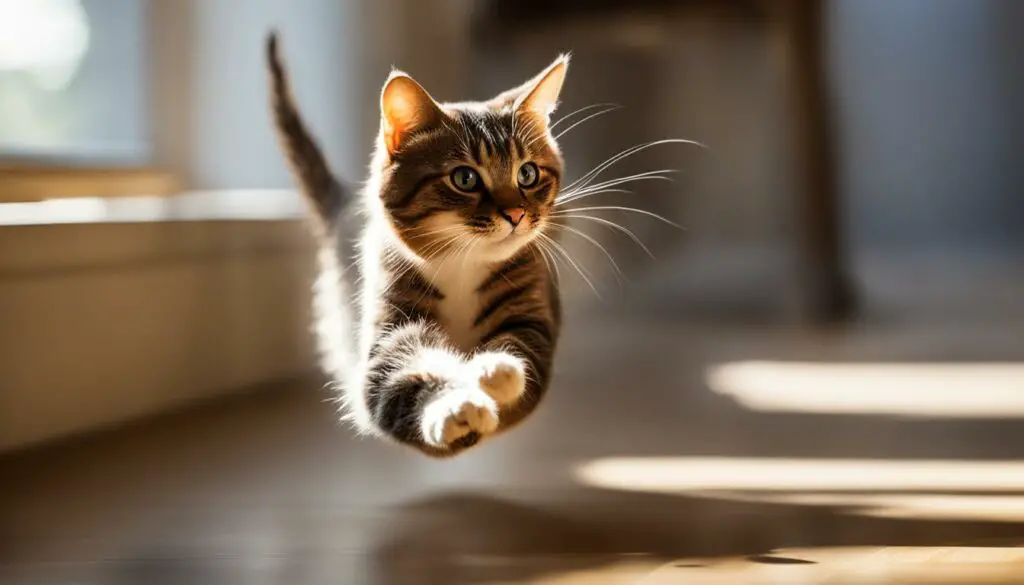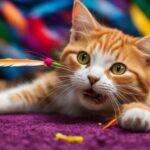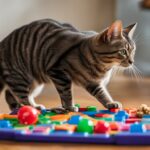Welcome to the world of cat playtime! As a cat owner, you have the incredible opportunity to unlock pure joy and create a deep bond with your feline companion. Playing with cats not only provides endless fun but also offers numerous benefits for both you and your furry friend. In this article, I will guide you on how to enhance your cat’s playtime experience and make the most out of every moment of interaction. Let’s dive in and explore the wonderful world of engaging with cats!
Key Takeaways:
- Playing with cats is essential for their mental stimulation and physical exercise.
- Interactive cat toys such as puzzle toys, wand toys, and treat-dispensing toys can provide hours of fun.
- Playtime helps build a strong bond and trust between you and your cat.
- Create a playful environment with designated play areas and safe toys to enrich your cat’s experience.
- Tailor playtime activities to suit your cat’s age and preferences.
Understanding the Importance of Cat Play
Play is a crucial aspect of a cat’s life, providing them with mental stimulation, physical exercise, and an outlet for their natural instincts. Engaging in cat play not only helps prevent behavioral problems but also promotes overall well-being and happiness for your feline companion. Cats are curious creatures, and playtime allows them to explore their environment, release pent-up energy, and express their natural behaviors such as hunting and chasing.
By providing cat enrichment activities through play, you can help keep your cat mentally sharp and engaged. Puzzle toys, interactive wand toys with feathers or strings, laser pointers, and treat-dispensing toys are all excellent options to stimulate your cat’s curiosity and engage their natural hunting instincts. These toys provide outlets for mental and physical stimulation, helping to prevent boredom and destructive behaviors.
Regular play sessions also contribute to your cat’s physical health. Just as exercise is important for humans, it is equally crucial for cats. Engaging in play helps cats burn calories, maintain a healthy weight, and reduce the risk of obesity-related health issues. Additionally, playtime aids in the development of strong muscles and improves agility, keeping cats physically fit and active.
The Benefits of Cat Play:
- Provides mental stimulation and prevents boredom
- Allows cats to express natural hunting behaviors
- Helps prevent behavioral problems
- Promotes physical exercise and maintains a healthy weight
- Builds a stronger bond between cats and their owners
Now that we understand the importance of cat play, let’s explore different types of interactive cat toys and how they can enhance your cat’s play experiences.
Table: Benefits of Cat Play
| Benefit | Explanation |
|---|---|
| Mental stimulation | Play engages your cat’s mind, keeping them mentally sharp and preventing boredom. |
| Physical exercise | Regular play sessions help cats burn calories, maintain a healthy weight, and improve agility. |
| Prevents behavioral problems | Play provides an outlet for natural instincts, helping to prevent destructive behaviors. |
| Bonding with owners | Engaging in play sessions creates a stronger bond between cats and their owners. |
Types of Interactive Cat Toys
When it comes to keeping your feline friend entertained and engaged, interactive cat toys are a must-have. These toys not only provide mental stimulation but also allow your cat to indulge in their natural hunting instincts. Here are some popular types of interactive cat toys that are sure to keep your furry companion entertained for hours:
1. Interactive Puzzle Toys: These toys are designed to challenge your cat’s problem-solving skills. They often require your cat to figure out how to get a treat or a toy hidden within the puzzle. Interactive puzzle toys provide mental stimulation and keep your cat engaged.
2. Wand Toys: Wand toys are a great choice for interactive play sessions. They typically feature feathers, strings, or other enticing attachments at the end of a wand. You can move the wand in different directions to mimic the movements of prey, allowing your cat to pounce, chase, and bat at the toy.
3. Laser Pointers: Laser pointers can provide endless fun for your cat. Simply shine the laser on the floor or walls, and watch as your cat chases and pounces on the elusive red dot. However, it’s important to never shine the laser pointer directly into your cat’s eyes.
4. Treat-Dispensing Toys: These toys are a fantastic way to combine playtime with a tasty reward. You can fill them with your cat’s favorite treats or kibble, and watch as they bat, roll, and figure out how to release the treats. Treat-dispensing toys keep your cat mentally stimulated and encourage them to work for their food.
With these interactive cat toys, you can provide your feline friend with endless entertainment and mental stimulation. Remember to choose toys that are safe and suitable for your cat’s age and play preferences. Rotate the toys regularly to keep things interesting and engage in interactive play sessions to bond with your furry companion. Happy playing!
Bonding with Your Cat Through Play
Engaging in interactive play sessions with your cat is not only a fun way to spend time together, but it also helps create a strong bond and build trust between you and your feline friend. When you play with your cat, you are providing them with mental stimulation, physical exercise, and an opportunity to engage in their natural behaviors. This helps them associate positive experiences with you, strengthening your relationship.
During playtime, it’s important to engage with your cat in a way that they enjoy. Pay attention to their body language and preferences. Some cats may prefer chasing after toys, while others may prefer pouncing or swatting. Observe what brings out their playful side and tailor your play sessions to their liking.
Playing with your cat also provides an opportunity for communication. Use playtime as a chance to show your cat love and affection. Talk to them in a soothing voice, pet them gently, and reward them with treats or praise when they exhibit positive behaviors. This not only strengthens the bond between you and your cat but also helps them feel secure and loved.
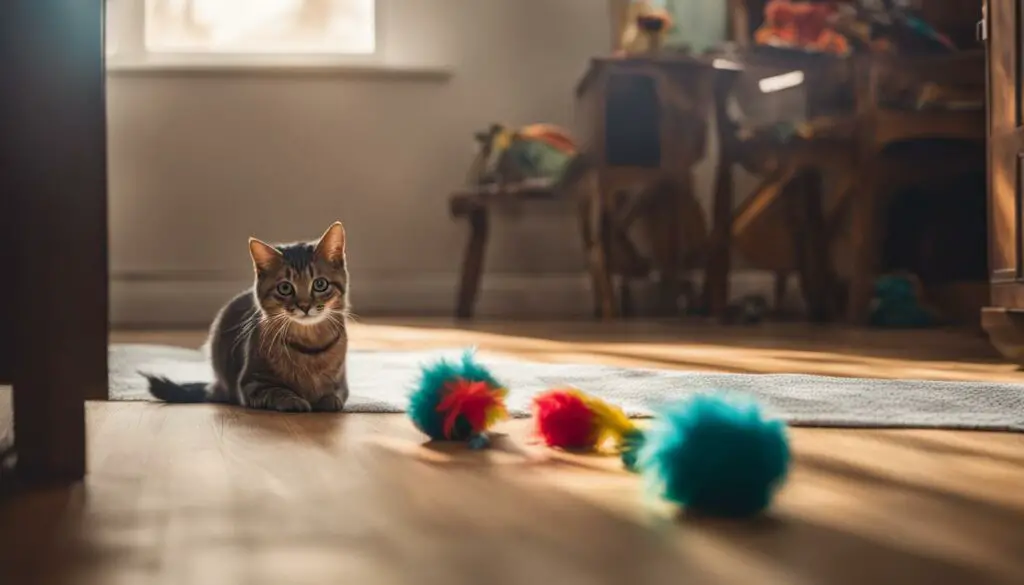
Tips for Bonding with Your Cat Through Play:
- Choose toys that stimulate your cat’s natural instincts, such as toys that mimic prey or objects they can pounce on.
- Experiment with different types of toys, such as wand toys, laser pointers, or puzzle toys, to keep playtime interesting and engaging.
- Create a safe and comfortable play environment for your cat, free from distractions or potential hazards.
- Make playtime a regular part of your cat’s daily routine to establish a consistent bonding experience.
- Be patient and understanding with your cat. Give them space if they need it and respect their boundaries.
By bonding with your cat through play, you can create a deeper connection and strengthen your relationship. Remember to make playtime enjoyable and engaging for both you and your cat, and cherish the special moments of connection and joy that play brings.
Creating a Playful Environment
Creating a playful environment for your cat is essential for their overall well-being. By setting up designated play areas, providing appropriate toys, and ensuring a cat-friendly home, you can encourage your feline friend to engage in play and explore their natural instincts.
One way to create a playful environment is by setting up designated play areas throughout your home. These areas can be equipped with toys, scratching posts, and interactive play stations. Placing these play areas in different rooms allows your cat to have options and ensures that playtime remains engaging and exciting.
It’s important to provide a variety of toys that cater to different play styles and preferences. Interactive puzzle toys, wand toys with feathers or strings, treat-dispensing toys, and laser pointers are some popular options that can keep your cat entertained and mentally stimulated. Remember to rotate the toys regularly to keep them fresh and interesting.
In addition to toys, it’s crucial to create a safe and cat-friendly environment. Provide hiding spots, such as cardboard boxes or cat tunnels, where your cat can retreat and feel secure. Vertical spaces, such as cat trees or shelves, can also be beneficial as they allow your cat to climb and observe their surroundings.
| Playful Environment Checklist | |
|---|---|
| Designate play areas in different rooms | |
| Provide a variety of toys | |
| Rotate toys regularly | |
| Offer hiding spots and vertical spaces |
By creating a playful environment for your cat, you are providing them with opportunities to engage in play on their terms. This not only keeps them physically and mentally stimulated but also enhances their overall well-being and happiness.
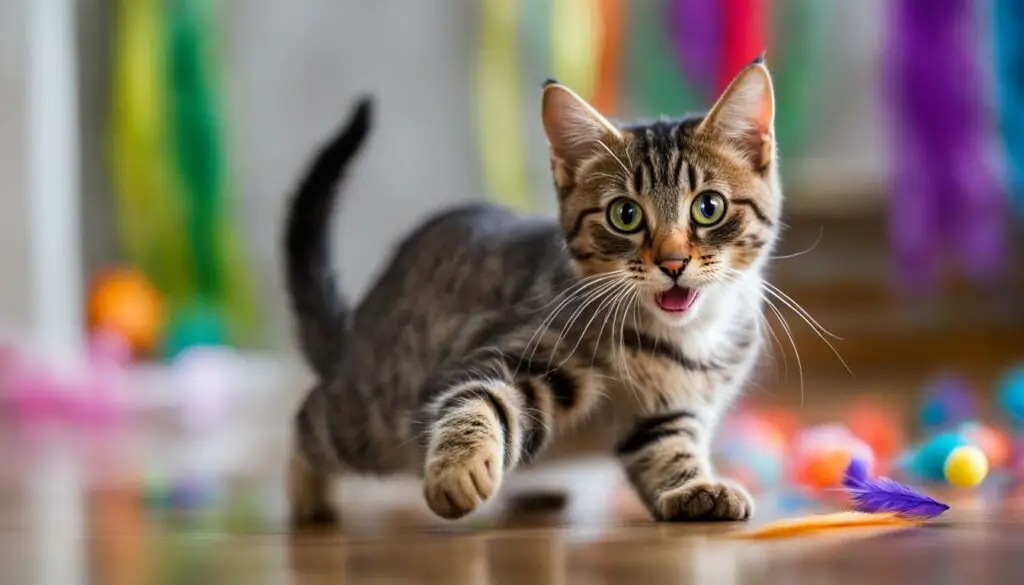
Play Ideas for Cats of All Ages
Engaging in playtime activities is essential for cats of all ages. Each stage of a cat’s life comes with its own play preferences and energy levels. Tailoring playtime activities to suit your cat’s age and preferences can ensure a fulfilling and enjoyable play experience.
Kittens: Kittens are full of energy and curiosity. They thrive on interactive play that mimics their natural hunting instincts. Provide them with a variety of toys that encourage chasing, pouncing, and climbing. Wand toys with feathers or strings, crinkle balls, and small interactive puzzle toys are great options for engaging kittens.
Adult Cats: Adult cats still enjoy interactive play but may also appreciate independent play with toys. Rotate their toys regularly to keep them interested. Laser pointers, treat-dispensing toys, and interactive puzzle toys can provide mental stimulation and keep adult cats entertained.
Senior Cats: Senior cats may have lower energy levels and prefer more gentle play sessions. Focus on activities that promote mental stimulation and engage their senses. Interactive puzzle toys that dispense treats, feather wands, and soft plush toys can provide gentle stimulation for senior cats.
Table: Play Ideas for Cats of All Ages
| Age | Play Ideas |
|---|---|
| Kittens | Interactive play with wand toys, crinkle balls, and puzzle toys |
| Adult Cats | Interactive play with laser pointers, treat-dispensing toys, and puzzle toys; independent play with a variety of toys |
| Senior Cats | Gentle play with interactive puzzle toys, feather wands, and plush toys |
Remember, safety is always a priority during playtime. Ensure that play sessions are supervised, and avoid small toys or strings that can pose a choking hazard. Playtime is a wonderful opportunity to bond with your cat and provide them with mental and physical stimulation. Enjoy exploring different play ideas with your feline companion and create memorable moments together.
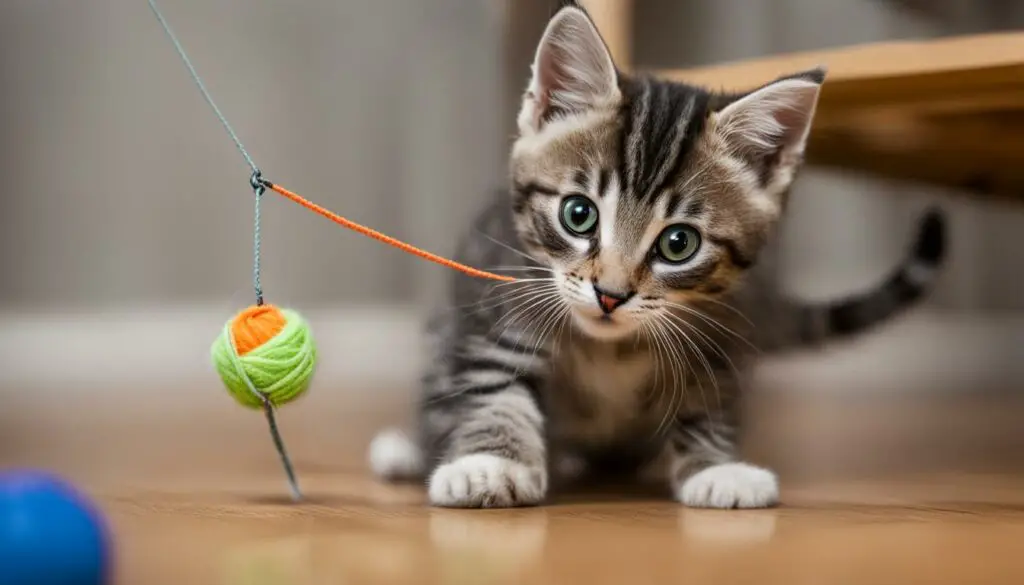
Incorporating Play into Daily Routine
As a cat owner, incorporating playtime into your cat’s daily routine is essential for their overall well-being. By setting aside dedicated play sessions throughout the day, you can provide your cat with regular mental and physical stimulation, preventing boredom and promoting a healthy lifestyle.
During playtime, engage in activities that your cat enjoys, such as chasing toys or interactive play with you. Aim for interactive play sessions that last between 10-15 minutes, a few times a day. This will help burn off your cat’s excess energy and keep them entertained.
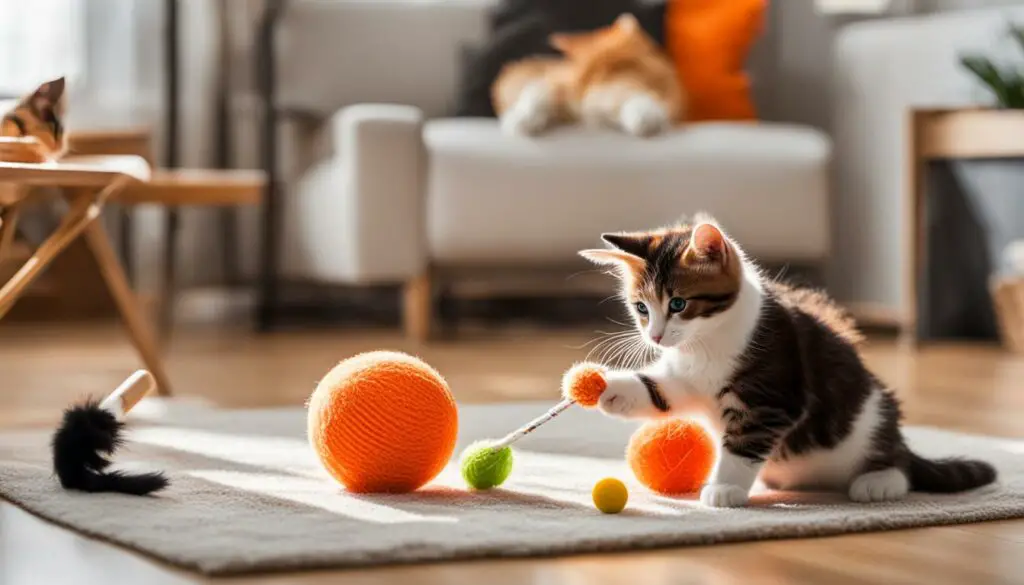
Not only does incorporating play into your cat’s daily routine help prevent behavioral problems, but it also strengthens the bond between you and your feline friend. Use playtime as an opportunity to communicate with your cat, showing them love and affection. By engaging in interactive play sessions, your cat will associate positive experiences with you, fostering a deeper connection.
Remember to tailor your playtime activities to suit your cat’s age and preferences. Kittens may require more active and stimulating play sessions, while senior cats may prefer gentler play that focuses on mental stimulation. By understanding your cat’s needs, you can ensure that playtime is enjoyable and fulfilling for both of you.
Understanding Cat Body Language During Play
During playtime, it’s important to pay attention to your cat’s body language to ensure a positive and safe experience. Cats communicate through their body movements and behaviors, and understanding these cues can help you engage with them effectively. Here are some key signs to look out for:
- Dilated pupils: Wide, dilated pupils may indicate excitement or arousal during play. It’s a sign that your cat is fully engaged and focused on the game.
- Flattened ears: If your cat’s ears are pressed flat against their head, it may be a sign of anxiety or overstimulation. This could mean that the play session is becoming too intense, and it’s time to take a break.
- Lashing tail: A tail that is flicking back and forth rapidly can indicate agitation or frustration. It’s important to give your cat a break if you notice this behavior, as it may signal that they are becoming overwhelmed.
- Purring: Purring is a sign of contentment and relaxation in cats. If your cat is purring during play, it’s a good indication that they are enjoying themselves and feel safe with you.
- Relaxed body posture: A relaxed cat will have a loose body posture, with their tail held low or gently swaying. This is a positive sign that they are comfortable and having a good time.
- Focused attention: If your cat is fully focused on the toy or game, with their eyes fixed on the target and body poised for action, it shows that they are actively participating and enjoying the play session.
By observing these behaviors, you can ensure that your cat’s playtime is enjoyable and stress-free. Remember to always respect your cat’s boundaries and provide them with breaks when needed. Each cat is unique, so take the time to learn their individual body language and respond accordingly.
Playtime is a wonderful opportunity to bond with your cat and strengthen your relationship. Understanding and interpreting their body language during play will not only enhance the play experience, but also deepen the trust and connection between you and your feline friend.
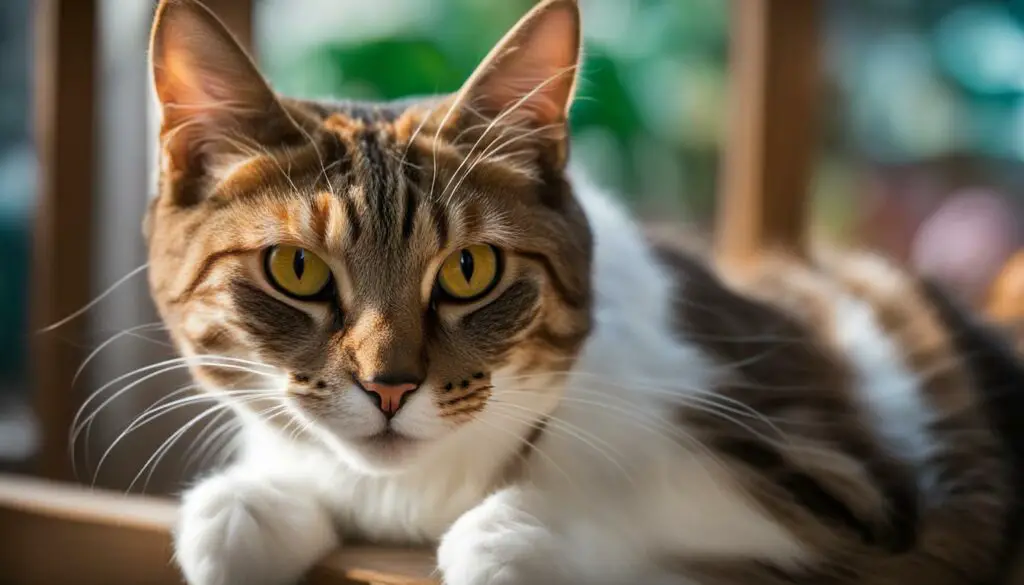
Fun Playtime Activities for Indoor Cats
Indoor cats require stimulating playtime activities to keep them mentally and physically engaged. Here are some engaging cat play ideas that will keep your feline friend entertained and satisfied:
1. Interactive Puzzle Toys
Interactive puzzle toys are a fantastic way to challenge your indoor cat’s problem-solving skills. These toys often have hidden compartments or treat rewards that will keep your cat engaged and mentally stimulated. Hide treats or kibble in the puzzle toy and watch as your cat tries to figure out how to retrieve them.
2. Feather Wand Toys
Feather wand toys provide an excellent opportunity for interactive play and mimic hunting behaviors. Cats love to chase and pounce on feather wand toys as they mimic the movement of birds or insects. Engage your cat in a fun game of “catch the feather” and let them unleash their inner hunter.
3. Laser Pointers
Laser pointers are a popular choice for indoor cats as they stimulate their natural predatory instincts. Use a laser pointer to create an enticing light trail for your cat to chase. Remember to never shine the laser pointer directly into your cat’s eyes and always end the play session with a physical toy or treat to provide a sense of completion.
Remember to always supervise play sessions with your cat and provide a variety of toys to prevent boredom. Rotate the toys regularly to keep the playtime activities fresh and exciting for your feline friend.
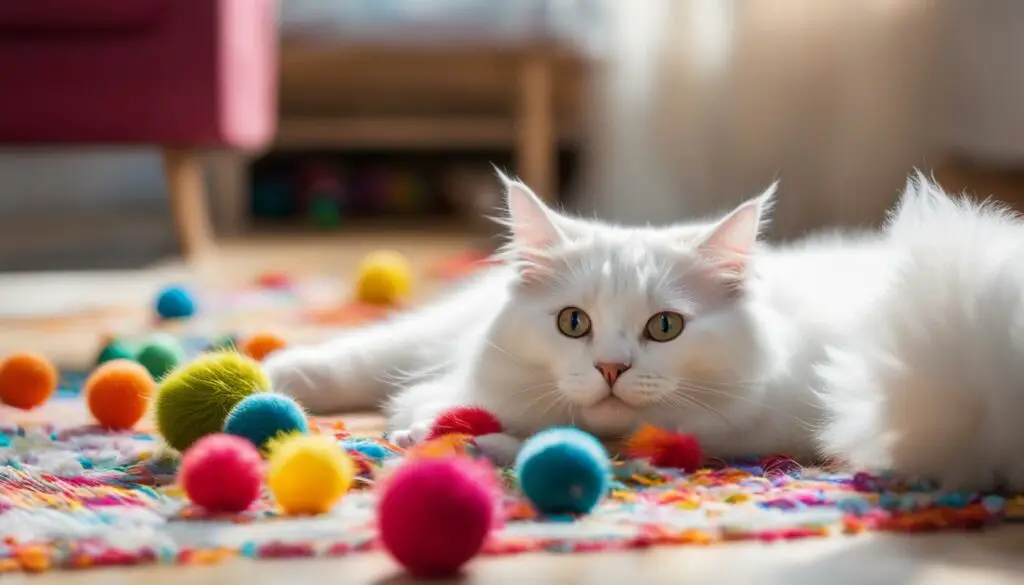
Table: Recommended Indoor Cat Playtime Activities
| Activity | Description |
|---|---|
| Interactive Puzzle Toys | Stimulate your cat’s problem-solving skills with interactive puzzle toys that hide treats or kibble. |
| Feather Wand Toys | Mimic hunting behaviors with feather wand toys that simulate the movement of birds or insects. |
| Laser Pointers | Engage your cat’s predatory instincts with a laser pointer, providing an enticing light trail to chase. |
“Playtime is essential for indoor cats to keep them mentally and physically stimulated. By providing engaging activities such as puzzle toys, feather wands, and laser pointers, you can create a fun and fulfilling playtime experience for your feline friend.”
– Cat Behavior Expert
Outdoor Playtime Safety Tips
When allowing your cat to go outside for playtime, it’s important to prioritize their safety and well-being. Here are some essential tips to ensure a safe and enjoyable outdoor play experience:
Evaluate Your Outdoor Space
Before letting your cat explore the great outdoors, assess your outdoor space to ensure it’s safe and secure. Check for any potential hazards like toxic plants, open gates, or gaps in fences that your cat could escape through. Create a designated outdoor area, such as a properly enclosed backyard or a catio, where your cat can play freely without the risk of running into danger.
Supervise Outdoor Play Sessions
Always supervise your cat’s outdoor play sessions. This will allow you to closely monitor their activities and intervene if necessary. Keep a watchful eye on your cat’s interactions with other animals, ensuring that they are positive and non-threatening. Additionally, be aware of any signs of distress or discomfort, and be prepared to bring your cat back indoors if needed.
Use Proper Identification and Control
Make sure your cat is wearing a well-fitting collar with identification tags that include your contact information. In case your cat wanders off or gets lost, this will greatly increase the chances of a safe return. Consider using a harness and leash for added control and safety during outdoor playtime, especially if your cat is not accustomed to being outside or easily spooked.
By following these outdoor playtime safety tips, you can provide your cat with a stimulating and secure environment to enjoy the wonders of the outdoors. Remember, engaging with your cat in a safe and controlled manner ensures a rewarding play experience for both you and your feline friend.
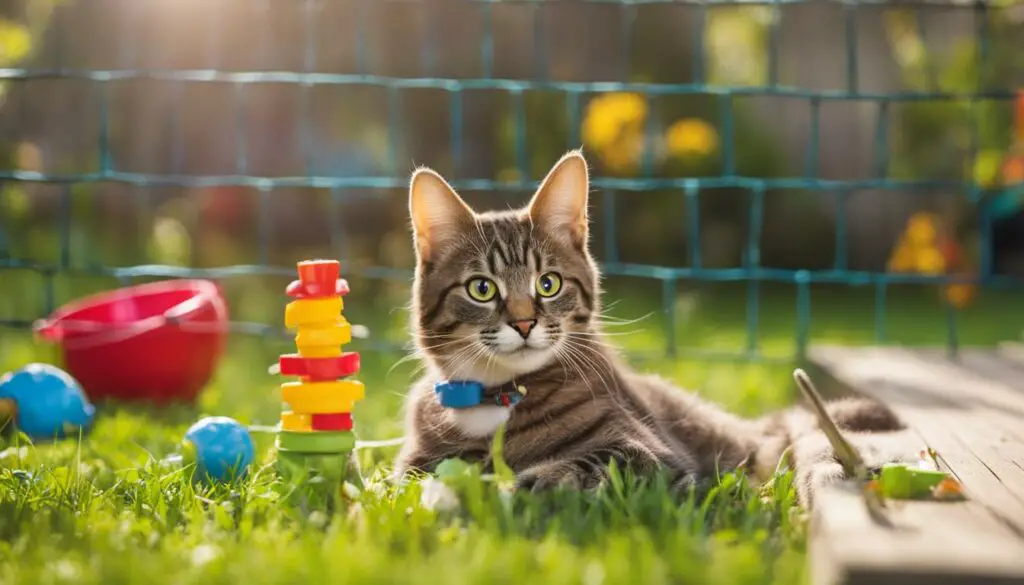
| Outdoor Playtime Safety Tips |
|---|
| 1. Evaluate Your Outdoor Space |
| 2. Supervise Outdoor Play Sessions |
| 3. Use Proper Identification and Control |
Playtime Etiquette for Kids and Cats
Engaging with cats is not only a source of joy but also a learning experience for kids. However, it’s important to teach them proper playtime etiquette to ensure the safety and well-being of both the children and the cats. By following a few simple guidelines, kids can enjoy playful interactions with cats while respecting their boundaries and needs.
First and foremost, it’s crucial to educate children about gentle handling. Cats have delicate bodies, and rough play can lead to injuries or distress. Teach kids to stroke cats gently, avoiding pulling their tail or ears. Encourage them to use soft voices and calm movements to create a peaceful and relaxed atmosphere during playtime.
Respecting a cat’s boundaries is also essential. Cats are independent creatures and enjoy their personal space. Teach children to observe a cat’s body language and to recognize signs of discomfort or stress. If the cat shows any signs of agitation, such as hissing, swatting, or trying to escape, it’s important to give the cat space and allow it to retreat to a safe area.
Supervision is key when kids interact with cats. Adult supervision ensures that playtime remains safe and enjoyable for both parties. Parents or guardians should always be present during play sessions to step in if any rough behavior occurs or if the cat becomes overwhelmed.
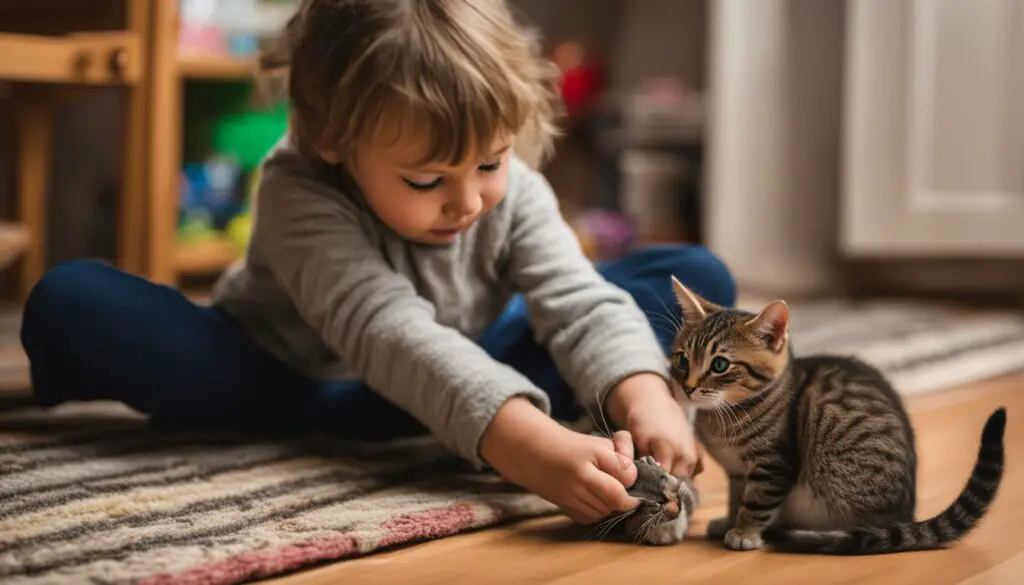
Remember, positive reinforcement is essential when teaching kids proper playtime etiquette with cats. Encourage positive interactions and praise them for gentle play. This will help children develop empathy and understanding for animals, fostering a positive relationship between kids and cats.
Mental Stimulation for Cats
Cats are curious creatures who thrive on mental stimulation. Engaging them in enriching activities is not only entertaining but also essential for their overall well-being. By providing opportunities for mental exercise, you can keep your feline friend engaged, happy, and mentally sharp.
One way to mentally stimulate your cat is by incorporating puzzle toys into their playtime. These toys challenge their problem-solving skills and provide mental stimulation as they figure out how to retrieve treats or toys hidden inside. Puzzle toys come in various designs, such as treat-dispensing balls or interactive toys with hidden compartments. They encourage cats to use their cognitive abilities and keep them entertained for hours.
Sensory enrichment activities are another great way to provide mental stimulation for your cat. Create a sensory garden indoors by placing pots of cat-friendly plants like catnip or cat grass. These plants engage their sense of smell and provide a stimulating environment. You can also introduce different textures and surfaces for them to explore, such as scratching posts with different materials or toys with different textures. This variety keeps their senses engaged and enriches their playtime experience.
Interactive play sessions that mimic natural hunting behaviors are also mentally stimulating for cats. Use wand toys with feathers or strings to imitate prey movements and encourage your cat to chase and pounce. This type of play allows them to engage their instincts and provides mental stimulation as they strategize their moves. Remember to always supervise interactive play sessions to ensure safety and prevent accidents.
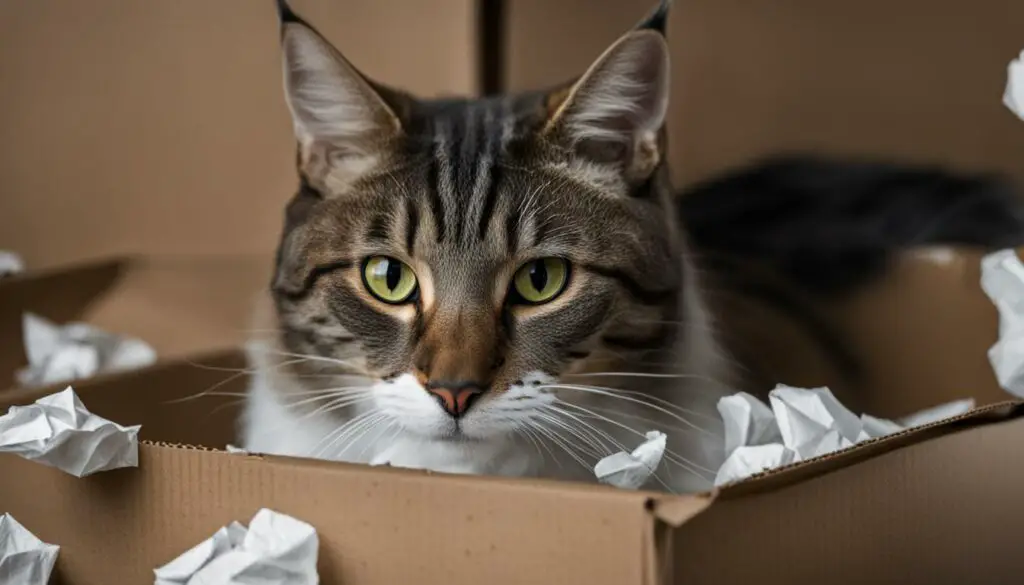
By incorporating these mental stimulation activities into your cat’s routine, you can provide them with a fulfilling and engaging environment. Cats thrive when their minds are challenged, and by keeping them mentally stimulated, you can help prevent boredom and behavioral issues. So, unleash your cat’s inner genius and watch as they enjoy a world filled with mental enrichment and endless possibilities.
Socializing Your Cat Through Play
Playtime can be a valuable tool for socializing your cat and helping them feel comfortable around other people and animals. By engaging in interactive play sessions, you can create positive associations for your cat and build their confidence in social environments. Here are some tips to help you socialize your cat through play:
- Introduce new experiences gradually: When introducing your cat to new people or animals, start with controlled, positive interactions. Use playtime as an opportunity to introduce new stimuli and gauge your cat’s comfort level. Gradually increase the complexity of the social interactions over time.
- Encourage positive interactions: During play sessions, reward your cat with treats or praise for engaging in positive behaviors. This will help them associate social interactions with positive experiences. Avoid forcing your cat to interact if they show signs of discomfort or fear.
- Provide a safe and calm environment: Create a quiet and calm environment for social play sessions. This will help your cat feel more relaxed and at ease. Avoid loud noises or sudden movements that could startle your cat and cause them to retreat.
- Involve other family members: Encourage other family members to participate in play sessions with your cat. This will help your cat become comfortable with different individuals and build their social skills.
Playtime is not only about physical exercise but also about fostering social connections. By incorporating play into your cat’s routine, you can help them develop the necessary social skills to navigate different environments and feel confident in social interactions.
Socialization Progress Tracking Table:
| Activity | Frequency | Outcome |
|---|---|---|
| Playtime with new person | Twice a week | Initially hesitant, but now showing curiosity and engagement |
| Introducing to other pets | Once a week | Slowly becoming more comfortable, starting to show signs of playfulness |
| Playdates with other cats | Once a month | Initial caution, but now enjoying interactive play with other cats |
Tracking your cat’s socialization progress can help you monitor their development and identify areas where they may need additional support. Remember, each cat is unique, so be patient and allow them to set the pace for their socialization journey.
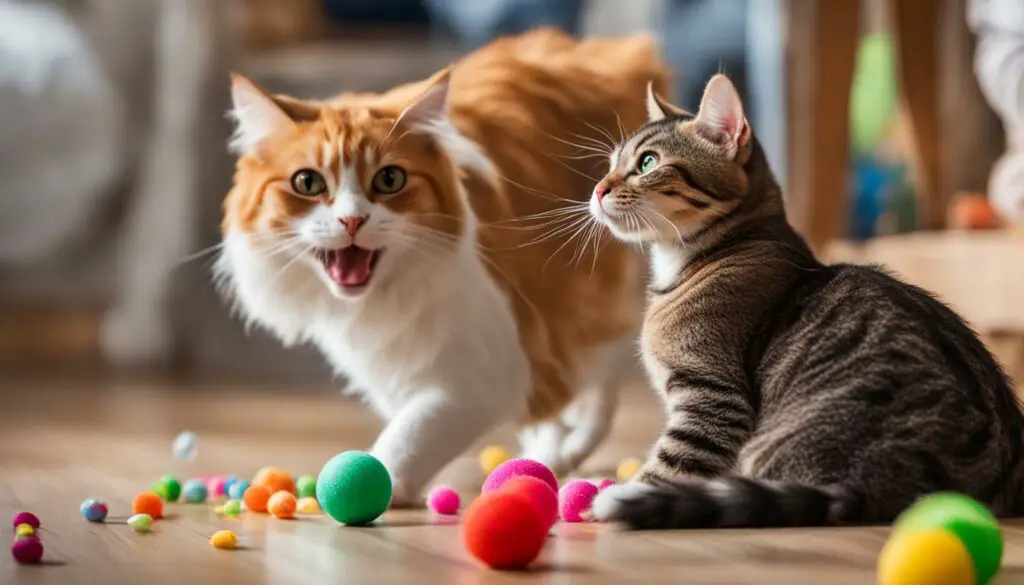
Health Benefits of Cat Play
Engaging in regular play sessions with your cat provides numerous health benefits. Play helps keep cats physically active, reducing the risk of obesity and related health issues. It also promotes mental stimulation, enhancing cognitive function and preventing boredom-related behavior problems. By providing opportunities for cats to engage in natural behaviors through play, their overall well-being is maintained.
Cat exercise is essential for maintaining a healthy weight and preventing obesity. Regular play sessions help burn calories and keep cats physically fit. This is especially important for indoor cats who may have limited opportunities for exercise. Incorporating interactive toys, such as wand toys or laser pointers, can simulate hunting behaviors and provide a much-needed outlet for their energy.
In addition to physical exercise, cat play also promotes mental stimulation. Interactive play sessions require cats to use their problem-solving skills, keeping their minds sharp and active. Puzzle toys and food-dispensing toys challenge cats to think and strategize, providing mental enrichment. This not only prevents boredom but also helps prevent the development of destructive behaviors that may arise from a lack of mental stimulation.
Incorporating Playtime into Your Routine
Playtime is an essential part of your cat’s daily routine, providing mental and physical stimulation. By incorporating playtime into your schedule, you can enhance your cat’s overall well-being and strengthen your bond. Whether you have a few minutes or a longer session, it’s important to make playtime a priority in your daily routine.
Start by setting aside dedicated time for play sessions. Aim for at least two interactive play sessions per day, each lasting 10-15 minutes. During this time, engage your cat with interactive toys such as wand toys, laser pointers, or treat-dispensing toys. This will help them burn off energy, exercise their natural hunting instincts, and keep them entertained.
Remember to tailor the play activities to your cat’s preferences and age. Young kittens may require more active play sessions, while adult cats may prefer a mix of interactive and independent play. For senior cats, focus on gentle play sessions that provide mental stimulation. Observe your cat’s body language and adjust the intensity of play accordingly.
Make playtime a positive and rewarding experience for both you and your cat. Use this time to bond with your feline friend, showing them love and affection. Celebrate their achievements, such as catching a toy or solving a puzzle, with praise and treats. By incorporating playtime into your routine, you can create a joyful and enriching environment for your cat.
Benefits of Incorporating Playtime into Your Routine
- Physical exercise: Playtime helps keep your cat active, reducing the risk of obesity and related health issues.
- Mental stimulation: Interactive play sessions challenge your cat’s problem-solving skills and prevent boredom-related behavior problems.
- Bonding and socialization: Playtime strengthens your bond with your cat and helps them feel more comfortable around other people and animals.
- Enrichment and fun: Playtime provides your cat with the opportunity to engage in natural behaviors and have fun.
By incorporating playtime into your routine, you can provide your cat with the physical and mental stimulation they need, while also creating lasting memories and moments of joy.
| Playtime Tips | |
|---|---|
| 1. | Set aside dedicated time for play sessions. |
| 2. | Use interactive toys to engage your cat’s natural instincts. |
| 3. | Observe your cat’s body language and adjust the intensity of play accordingly. |
| 4. | Celebrate your cat’s achievements with praise and treats. |
| 5. | Make playtime a positive and rewarding experience for both you and your cat. |
| 6. | Customize play activities based on your cat’s age and preferences. |
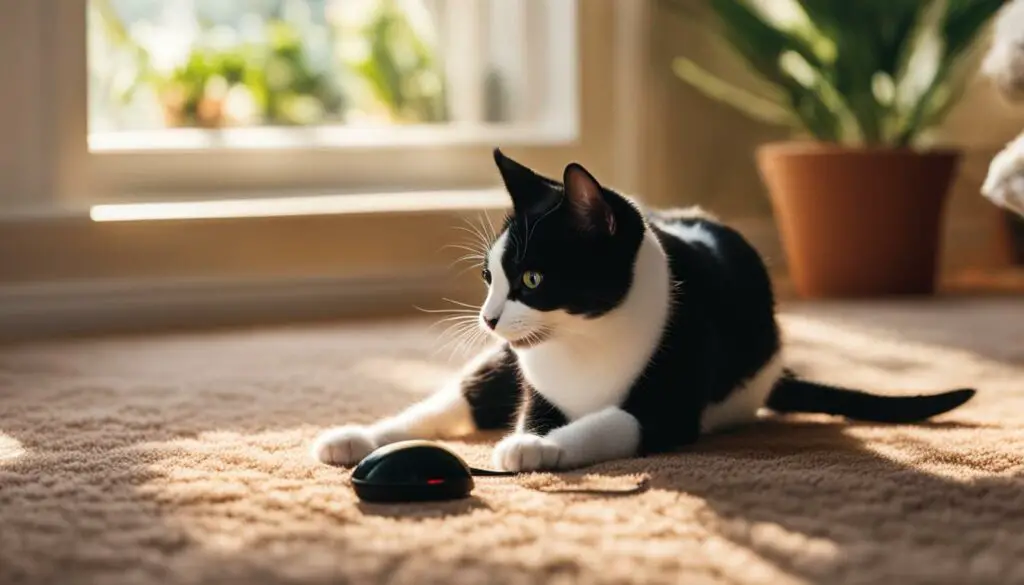
Playtime is an important aspect of caring for your cat and should be incorporated into your daily routine. By dedicating time for play sessions, using interactive toys, and observing your cat’s preferences, you can provide them with the mental and physical stimulation they need to thrive. Remember to make playtime a positive and rewarding experience, celebrating your cat’s achievements and strengthening your bond. Enjoy the moments of joy and playfulness that come with engaging in regular playtime with your feline friend.
Conclusion
Playing with cats is not only a source of fun and joy but also crucial for their overall well-being. By engaging in interactive play and providing cat enrichment activities, we can create a harmonious relationship with our feline friends. Through playtime, we can strengthen our bond, keep them physically active, and stimulate their minds.
By prioritizing regular play sessions, we can prevent boredom-related behavior problems and promote a healthy lifestyle for our cats. Whether it’s using interactive toys, engaging in puzzle games, or simply spending quality time together, playtime offers countless moments of connection and playfulness.
So, let’s unlock pure joy and create a playful environment for our cats. Incorporate playtime into your daily routine, tailor activities to your cat’s preferences and age, and reap the benefits of a strong bond and a happy, fulfilled feline companion. Enjoy the wonders of cat playtime and cherish the precious memories that it brings!
FAQ
Why is play important for cats?
Play provides mental stimulation, physical exercise, and helps prevent behavioral problems in cats.
What are some types of interactive cat toys?
Examples of interactive cat toys include puzzle toys, wand toys with feathers or strings, laser pointers, and treat-dispensing toys.
How can playtime with a cat strengthen the bond?
Engaging in interactive play sessions with a cat helps them associate positive experiences with you, building a stronger relationship.
How can I create a playful environment for my cat?
Set up designated play areas with toys and scratching posts, provide hiding spots and climbing spaces, and ensure your home is safe and cat-friendly.
How can I tailor playtime activities to my cat’s age?
Kittens may require more interactive play, adult cats enjoy a mix of interactive and independent play, and senior cats may prefer gentle play sessions focused on mental stimulation.
How often should I have dedicated play sessions with my cat?
Aim for interactive play sessions lasting 10-15 minutes a few times a day to prevent boredom and provide regular mental and physical stimulation.
How can I interpret my cat’s body language during play?
Pay attention to signs of overstimulation, such as dilated pupils and flattened ears, and watch for signs of enjoyment, such as purring and a relaxed body posture.
What are some fun playtime activities for indoor cats?
Indoor cats can enjoy puzzle toys, treat-dispensing toys, and interactive play sessions using wand toys or laser pointers to mimic hunting behaviors.
How can I ensure outdoor playtime is safe for my cat?
Always supervise outdoor play sessions, provide a safe and secure outdoor space, and consider using a well-fitting collar, identification tags, and a harness or leash.
What should kids know about playtime etiquette with cats?
Kids should be taught gentle handling, avoiding rough play, and respecting a cat’s boundaries. Supervised play sessions and recognizing cat body language are important.
How can I provide mental stimulation for my cat?
Incorporate puzzle toys, food-dispensing toys, new environments, and sensory enrichment activities to challenge your cat’s problem-solving skills and engage their senses.
How can playtime help socialize my cat?
Positive interactions and controlled introductions to new experiences and stimuli during playtime can help your cat feel comfortable around other people and animals.
What are the health benefits of cat play?
Play keeps cats physically active, reduces the risk of obesity, promotes mental stimulation, enhances cognitive function, and helps prevent boredom-related behavior problems.
How can I incorporate playtime into my daily routine?
Set aside dedicated time for play sessions, make it a priority to provide mental and physical stimulation, and enjoy the moments of connection and playfulness with your cat.

